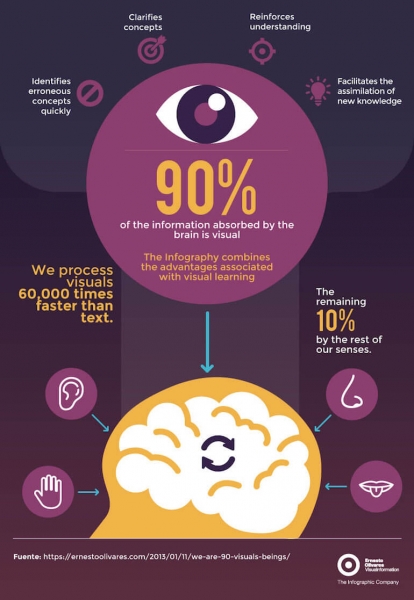I have to admit that I avoid long articles, blog posts and books, even though I like to read.If I see an exciting headline in my newsfeed and I click on it, I tend to read only what is marked, just to get an idea about what it says. On top of that, if I can understand what the article is about just by checking out the photo or video that comes with it, I usually skip the description part and close the window.
I know, it’s not nice. After all, there must be a reason why some of the articles are so long. In most cases, I’m sure that there is a huge amount of additional and essential information hidden between the rows. Unfortunately, for every useful article out there, I can find at least two articles only created to increase traffic and engagement on a certain blog.
Because the Internet is so crowded by these scam-articles, I tend to look suspiciously at every blog post that comes with a too promising headline. But that’s not the only reason why I prefer visual content over text. My lifestyle has changed and yours did too.
Blame technology
In the industry of content marketing, there are always two groups, formed by the ones who create the content and the ones who consume it. The difference is, that with the help of technology the creation of visual content goes faster (a lot faster) than the creation of text. Not everyone is skilled enough to write engaging articles, but almost everyone can create content (image or video) just by using their phone.
Social media sites like Pinterest, Instagram, Tumblr and Snapchat are the proof that people prefer visual content over text. According to TechCrunch, in January 2015, Pinterest had 88 million active users and surpassed 100 million in September.
You may wonder why these social media websites are so popular in these days. If they are mainly for posting and sharing visual content, then why do we need so many of them?
Pinterest is for content curators: for all of those who like to bookmark pages, subscribe to blogs, share photos and articles. It’s like an online scrapbook.
[Tweet “Pinterest it’s like an online scrapbook”]Snapchat is different. It’s full of energy and positive vibes. You will find funny pictures, animated visuals and short videos. It’s all about action and self-expression by making it easy for all of us to create visual content.
Have you heard about Vine videos? If I would try to match a social network to the word “fun”, then I would definitely say Vine! It’s for all of those who immediately need a good laugh. Is it difficult to create Vine videos? Of course not. You just have to hit a button and you are ready to go.
It’s hard-wired in our brains
There are several studies proving that we are visual beings. Even though we have five traditionally recognized senses (sight, hearing, taste, smell and touch), 90% of the transmitted information in the human brain is visual.
If you still doubt whether visual content or text is better, here is one additional fact that shows why you should focus on images and video in your marketing strategy:
‘3M Corporation’s research concluded that we process visuals 60.000 times faster than text.
That’s faster than any other way of perceiving and processing information.
Think of the first human beings. They didn’t have any books and they didn’t read at all. One to survive needed spontaneous interpretation of opportunities to reach things needed for survival or to avoid imminent danger. Visual signs were the first messengers. You have that in you.
Perceiving each other’s emotions
We are social beings. We can perceive each other’s emotions and we naturally desire the company of others on a regular basis. The technology was once at a level that it was mind blowing to imagine that text can be exchanged within people that are physically many miles away from each other.
Today, text somehow feels impersonal. You need stronger and more engaging ways to express or to perceive emotions. Now technology gives you that.
You don’t have to spend minutes of your valuable time to understand difficult words about how excited I am about a new service.
Instead of that, you can get a preview of that actual service, see photos of people’s reactions and watch video tutorials to see how it works.
Learning and satisfaction shortcuts
Every one of the modern well-educated public can think of a novel so long, that’s it’s hard to finish reading it. Sometimes, the real satisfaction is to get to the end and tell someone ‘yeah, I read that stuff like in 3 days or something’.
Visual content affects emotions faster than text by immediately heightening our creative thinking and stimulating other areas of our brain.
According to this article
visuals can trigger strong emotions in us, and we often tend to remember the pairing of emotions and visuals in vivid detail.
That’s extremely important for marketers and advertisers to know. If they want someone to remember their product, services or brand, they have to link it to visual elements: images, videos and even infographics might work.
You might see now why visual content matters so much in your marketing strategy. Please don’t forget that visual content is not enough to fully engage your customers. You must provide valuable information to them because that’s the ultimate reason why you are creating content in the first place.
Think about when and where would you like to post your image or video. It’s not always the best practice to follow someone’s advice.
For example, if someone says that the best moment to share an image on Facebook is on Saturdays at 2 p.m., it might not work for your type of business. You have to A/B test a lot and to analyze the engagement rate. After a while you will figure it out by yourself when and where is the best to share your visual content.
Conclusion
The visual content that you create should be related to all the blog posts, articles and case studies that you have on your website. It should have the power to make memorable all the other type of content that you have created.
Have you started to focus more on the creation of visual content? Did you include images, videos and infographics equally? What’s your strategy?
Let us know in a comment below!









1 Comment